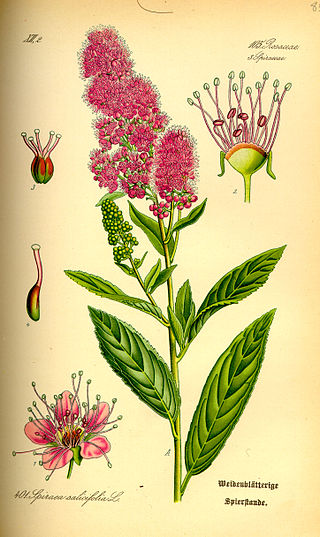
Spiraea, sometimes spelled spirea in common names, and commonly known as meadowsweets or steeplebushes, is a genus of about 80 to 100 species of shrubs in the family Rosaceae. They are native to the temperate Northern Hemisphere, with the greatest diversity in eastern Asia.
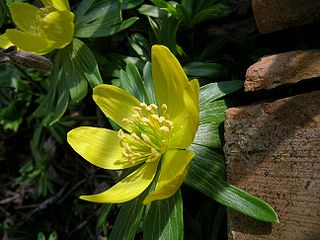
Eranthis is a genus of eight species of flowering plants in the buttercup family Ranunculaceae, native to southern Europe and east across Asia to Japan. The common name winter aconite comes from the early flowering time and the resemblance of the leaves to those of the related genus Aconitum, the true aconite. Like the notoriously toxic AconitumEranthis is poisonous, although its chemistry is different, the toxic compounds present being mainly cardiac glycosides of the bufadienolide group similar to those found in Adonis vernalis, rather than the virulent alkaloids of Aconitum.

Logania is a genus of plants belonging to the family Loganiaceae. Native to Australia and New Zealand, the genus includes at least 24 species including herbs, shrubs, trees and climbers.
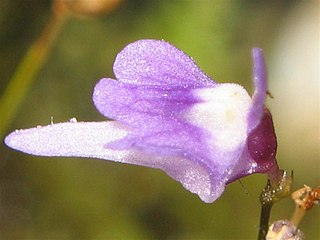
Utricularia minutissima is a small or very small terrestrial carnivorous plant that belongs to the genus Utricularia. U. minutissima is native to Asia and Australia. Among the islands of Southeast Asia, it is found on Borneo, New Guinea, and Sumatra.

Dalea albiflora, the whiteflower prairie clover or scruffy prairie clover, is a perennial subshrub or herb of the subfamily Faboideae in the pea family-(Fabaceae). It is found in the southwestern United States and Northwestern Mexico in the states of Arizona, New Mexico, Sonora, and Chihuahua.

Boenninghausenia is a monotypic plant genus in the family Rutaceae. The sole species is Boenninghausenia albiflora, which occurs in Bhutan, Nepal, Pakistan, Kashmir, India, Indonesia, Philippines, Myanmar, Thailand, Laos, North Vietnam, China and Japan.

Asterolasia asteriscophora, commonly known as lemon starbush, is a species of slender, erect shrub in the family Rutaceae and is endemic to southern continental Australia. It has woolly, star-shaped hairs on its young branches, variably-shaped leaves covered with brownish or whitish hairs on the underside, and yellow flowers with woolly brown, star-shaped hairs on the back.

Aloe albiflora is a species of aloe indigenous to Madagascar with narrow, muricate leaves and widely campanulate, snow-white flowers that are 10mm long and 14mm across the mouth. Its nearest affinity, based on leaf characters only, is Aloe bellatula.

Goodenia albiflora, commonly known as white goodenia, is a species of flowering plant in the family Goodeniaceae and endemic to South Australia. It is a small, erect shrub with ridged stems, elliptic to egg-shaped, cauline leaves, racemes of white flowers with leaf-like bracteoles at the base, and oval fruit.
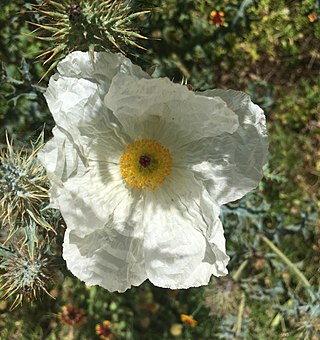
Argemone albiflora, the white prickly poppy, also known as the bluestem prickly poppy or the Texas prickly poppy, is a small erect plant with a decorative white flower with a yellow latex. It is deeply rooted with yellow or red stamens. The plant is known for the sharp prickles on its stem and leaves. The sepals fall off as the flower of this plant grows bigger. It grows in the arid regions of the southern Midwest along roadsides and disturbed pieces of land. Native Americans have long revered this plant for its medicinal and other uses.
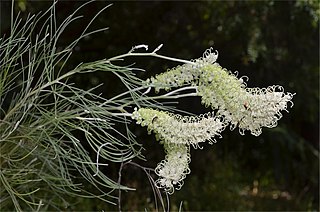
Grevillea albiflora, commonly known as white spider flower, is a species of flowering plant in the family Proteaceae and is endemic to inland eastern Australia. It is a shrub or small tree with pinnatisect leaves with linear lobes, and white to creamy-green flowers.

Metrosideros albiflora, also known as large white rātā, Northland white rātā, akatea or simply white rātā, is a forest liane or vine endemic to New Zealand. It is one of three white flowering rātā vines. The name "albiflora" indeed literally means white flowered. Despite the similar names, large white rātā is distinguished by its much larger leaves and flowers. Its flowers are amongst the largest of any rātā, similar in size to both scarlet rātā and pōhutukawa. It occurs almost exclusively in Kauri forests from the northern Kaimai Ranges to Te Paki at the top of the North Island.
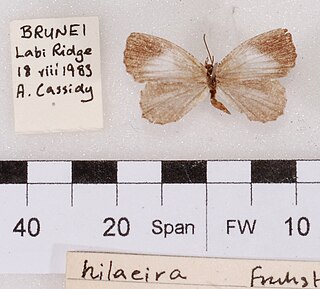
Logania marmorata, the pale mottle, is a butterfly in the family Lycaenidae. It was described by Frederic Moore in 1884. It is found in the Indomalayan realm.
Thelymitra albiflora, commonly called the white sun orchid, is a species of orchid that is endemic to South Australia. It has a single erect, narrow, fleshy leaf and up to ten relatively small white flowers with white toothbrush-like tufts on top of the anther.

Globba albiflora is a small plant in the ginger family, Zingiberaceae, sometimes called dancing ladies. This species can be found in Indo-China, Peninsular Malaysia and Sumatra; in Viet Nam the genus may likewise be called gừng vũ nữ or lô ba.

Boronia albiflora is a plant in the citrus family, Rutaceae and is endemic to the south-west of Western Australia. It is a soft shrub with pinnate leaves and pink or pink and white, four-petalled flowers.
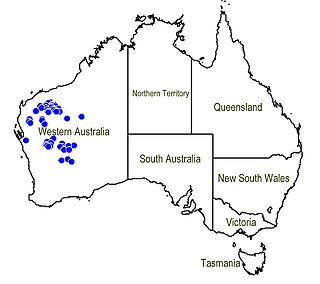
Prostanthera albiflora is a species of flowering plant in the family Lamiaceae and is endemic to inland areas of Western Australia. It is an erect, spreading shrub with narrow egg-shaped to narrow elliptical leaves and two to twelve white flowers with pale blue spots inside and arranged in the upper leaf axils.

Ornduffia calthifolia is a species of plant in the Menyanthaceae family of wetland plants that is endemic to Western Australia.
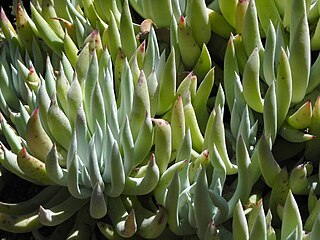
Dudleya albiflora, known by the common name white-flower liveforever, is a species of succulent perennial plant in the family Crassulaceae. It is native to the Baja California Peninsula. This species represents numerous populations with varying chromosome numbers scattered around the peninsula, but all share broad, common morphological traits such as white flowers and narrow leaves.

Myosotis albiflora is a species of flowering plant in the family Boraginaceae, native to southern Chile and Argentina. This species was described by Joseph Banks and Daniel Solander in Joseph Dalton Hooker's 19th century work Flora Antarctica. Plants of this species of forget-me-not are perennial and have white corollas. It is one of two native species of Myosotis in southern South America, the other being M. antarctica.





















